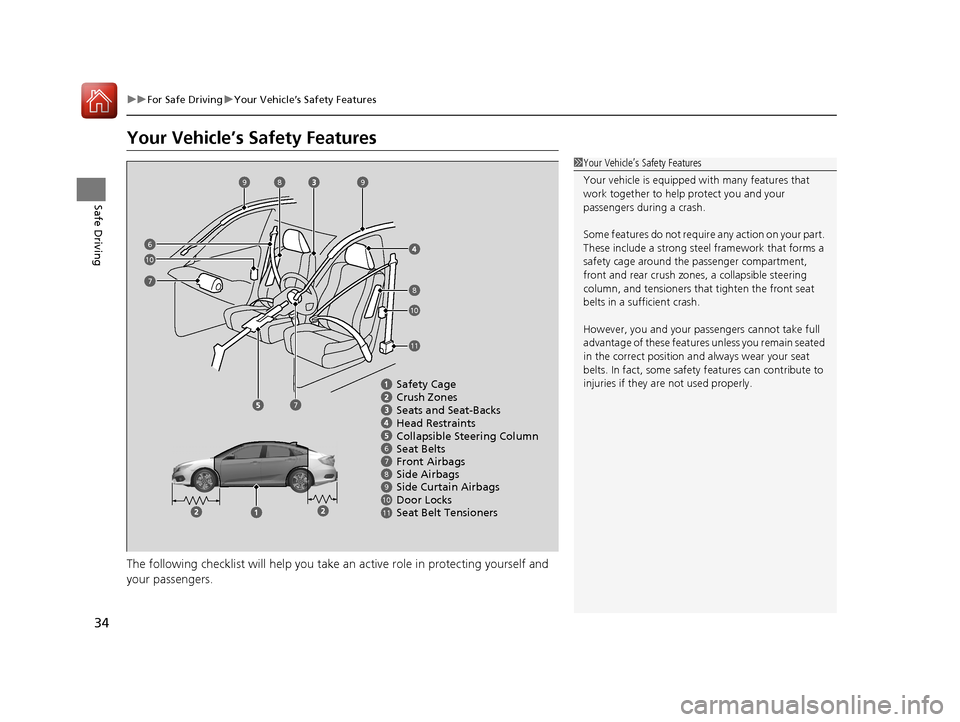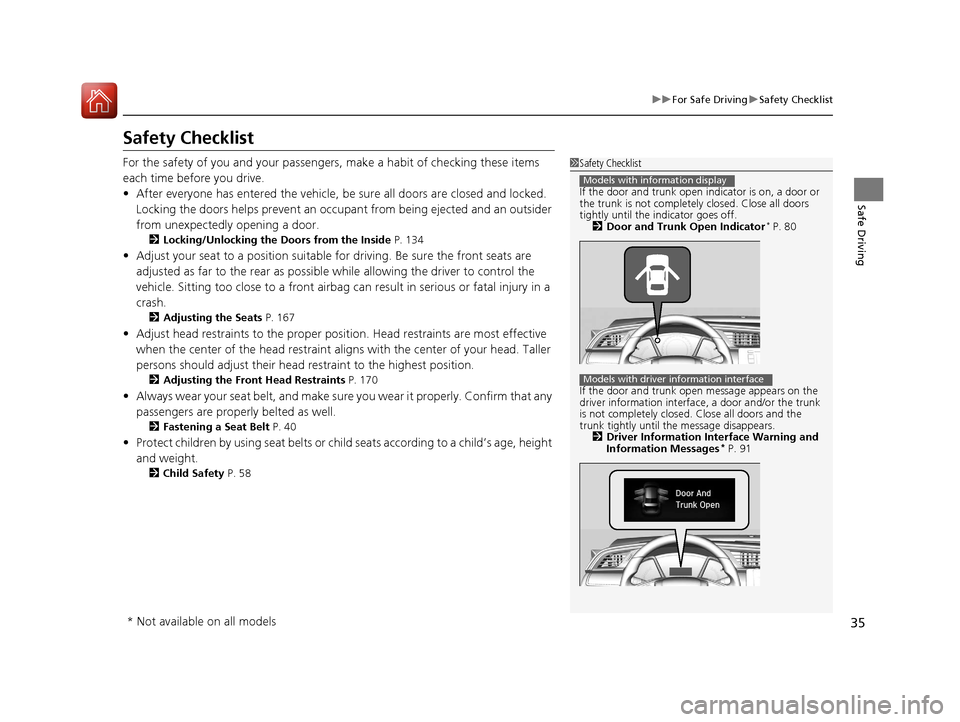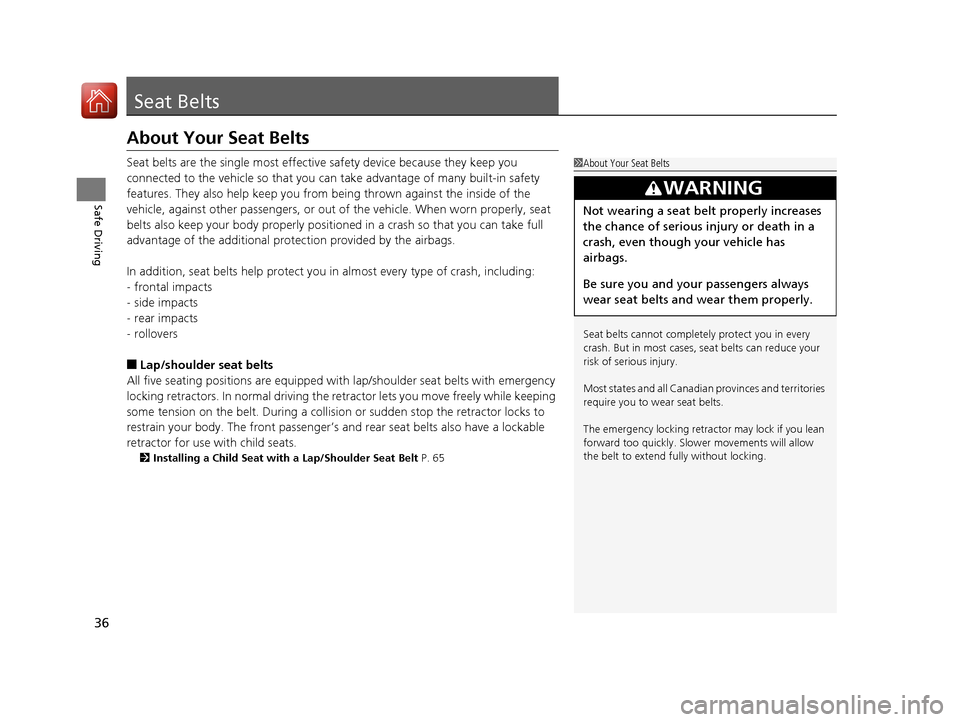Page 23 of 590
22
Quick Reference Guide
Audio system (P 198)
(P 205)Models with color audio system
(Seek/Skip) Button
RADIO Button
Driver Information Interface*
Button
AUX Button
Preset Buttons (1-6)
(Seek/Skip) Button
VOL
/ (Volume/Power) Knob
Audio/Information Screen
(Back) Button
(Sound) Button
MENU/CLOCK Button
LIST/SELECT (List/Selector)
Knob (Phone) Button
16 CIVIC 4D-31TBA6000.book 22 ページ 2015年8月31日 月曜日 午後5時56分
Page 25 of 590
24
Quick Reference Guide
Driving (P 389)
Release ButtonShift Lever
Depress the brake pedal and press the
release button to move out of
(P.
Move the shift lever without
pressing the release button. Press the release button to
move the shift lever.
Manual Transmission* (P 407)
Continuously Variable Transmission* (P 405)
● Shift to
(P and depress the brake pedal when starting the engine.
● Shifting
Park
Turn off or start the engine.
Transmission is locked.
Reverse
Used when reversing.
Neutral
Transmission is not locked.
Drive
Normal driving.
Drive (S)
●Better acceleration.●Increased engine braking.●Going up or down hills.
Low
●Further increased engine braking.●Going up or down hills.
16 CIVIC 4D-31TBA6000.book 24 ページ 2015年8月31日 月曜日 午後5時56分
Page 27 of 590
26
Quick Reference Guide
Maintenance (P 475)
Under the Hood (P 489)
● Check engine oil, engine coolant, and windshield washer
fluid. Add when necessary.
● Check brake fluid.
● Check the battery condition monthly.
aPull the hood release handle under the corner of the
dashboard.
bLocate the hood latch lever, pus h the lever in the center to
the right, and lift up the hood.
cWhen finished, close the hood and make sure it is firmly
locked in place.
Lights (P 504)
● Inspect all lights regularly.
Wiper Blades (P 514)
● Replace blades if they leave streaks
across the windshield.
Tires (P 516)
● Inspect tires and wheels regularly.
● Check tire pressures regularly.
● Install snow tires for winter driving.
16 CIVIC 4D-31TBA6000.book 26 ページ 2015年8月31日 月曜日 午後5時56分
Page 29 of 590

28
Quick Reference Guide
What to Do If
*1:Except U.S. models with continuously variable transmission
The ignition switch does
not turn from
(0 to (q.
Why?
The power mode does not
change from VEHICLE OFF
(LOCK) to ACCESSORY.
Why?
The steering wheel may be locked.
●Try to turn the steering wheel left and right
while turning the ignition key.
●Move the steering wheel left and right after pressing the
ENGINE START/STOP button.
The ignition switch does
not turn from
(q to (0 and
I cannot remove the key.
Why?
The power mode does not
change from ACCESSORY
to VEHICLE OFF (LOCK).
Why?
The shift lever should be moved to (P.
Why does the brake pedal
pulsate slightly when
applying the brakes?This can occur when the ABS activates, and does not indicate a
problem. Apply firm, steady pressure on the brake pedal. Never
pump the brake pedal.
Models without smart entry system
Models with smart entry system
Models without smart entry system
Models with smart entry system*1
Models without smart entry system
Models with smart entry system
16 CIVIC 4D-31TBA6000.book 28 ページ 2015年8月31日 月曜日 午後5時56分
Page 30 of 590

29
Quick Reference Guide
The rear door cannot be
opened from inside the
vehicle. Why?Check if the childproof lock is in the
lock position. If so, open the rear
door with the outside door handle.
To cancel this function, push the lever
to the unlock position.
Why do the doors lock
after I unlocked the doors
using a remote
transmitter?If you do not open the doors within 30 seconds, the doors are
relocked automatically for security.
Why does the beeper
sound when I open the
driver's door?The beeper sounds when:
●The key is left in the ignition switch*.
●The power mode* is in ACCESSORY.
●The exterior lights are left on.
Why does the beeper
sound when I start driving?The beeper sounds when the driver and/or front passenger are
not wearing their seat belts.
Why do I hear a screeching
sound when I apply the
brake pedal?The brake pads may need to be replaced. Have your vehicle
inspected by a dealer.
* Not available on all models
16 CIVIC 4D-31TBA6000.book 29 ページ 2015年8月31日 月曜日 午後5時56分
Page 35 of 590

34
uuFor Safe Driving uYour Vehicle’s Safety Features
Safe Driving
Your Vehicle’s Safety Features
The following checklist will help you take an active role in protecting yourself and
your passengers.
1 Your Vehicle’s Safety Features
Your vehicle is equipped wi th many features that
work together to help protect you and your
passengers during a crash.
Some features do not require any action on your part.
These include a strong steel framework that forms a
safety cage around the passenger compartment,
front and rear crush zone s, a collapsible steering
column, and tensioners that tighten the front seat
belts in a sufficient crash.
However, you and your passe ngers cannot take full
advantage of these features unless you remain seated
in the correct position and always wear your seat
belts. In fact, some safety features can contribute to
injuries if they are not used properly.
67891011
Safety Cage
Crush Zones
Seats and Seat-Backs
Head Restraints
Collapsible Steering Column
Seat Belts
Front Airbags
Side Curtain Airbags
Door Locks Side Airbags
Seat Belt Tensioners
7
7
99
8
8
10
10
6
11
16 CIVIC 4D-31TBA6000.book 34 ページ 2015年8月31日 月曜日 午後5時56分
Page 36 of 590

35
uuFor Safe Driving uSafety Checklist
Safe Driving
Safety Checklist
For the safety of you and your passengers, make a habit of checking these items
each time before you drive.
• After everyone has entered the vehicle, be sure all doors are closed and locked.
Locking the doors helps prevent an occupant from being ejected and an outsider
from unexpectedly opening a door.
2 Locking/Unlocking the Doors from the Inside P. 134
•Adjust your seat to a position suitable for driving. Be sure the front seats are
adjusted as far to the rear as possible while allowing the driver to control the
vehicle. Sitting too close to a front airbag can result in serious or fatal injury in a
crash.
2 Adjusting the Seats P. 167
•Adjust head restraints to the proper position. Head restraints are most effective
when the center of the head restraint aligns with the center of your head. Taller
persons should adjust their head restraint to the highest position.
2 Adjusting the Front Head Restraints P. 170
•Always wear your seat belt, and make sure you wear it properly. Confirm that any
passengers are properly belted as well.
2 Fastening a Seat Belt P. 40
•Protect children by using seat belts or chil d seats according to a child’s age, height
and weight.
2 Child Safety P. 58
1Safety Checklist
If the door and trunk open indicator is on, a door or
the trunk is not complete ly closed. Close all doors
tightly until the indicator goes off. 2 Door and Trunk Open Indicator
* P. 80
If the door and trunk open message appears on the
driver information interface , a door and/or the trunk
is not completely closed. Close all doors and the
trunk tightly until th e message disappears.
2 Driver Information Interface Warning and
Information Messages
* P. 91
Models with information display
Models with driver information interface
* Not available on all models
16 CIVIC 4D-31TBA6000.book 35 ページ 2015年8月31日 月曜日 午後5時56分
Page 37 of 590

36
Safe Driving
Seat Belts
About Your Seat Belts
Seat belts are the single most effective safety device because they keep you
connected to the vehicle so that you can take advantage of many built-in safety
features. They also help keep you from be ing thrown against the inside of the
vehicle, against other passengers, or out of the vehicle. When worn properly, seat
belts also keep your body pr operly positioned in a crash so that you can take full
advantage of the additional protec tion provided by the airbags.
In addition, seat belts help protect you in almost every type of crash, including:
- frontal impacts
- side impacts
- rear impacts
- rollovers
■Lap/shoulder seat belts
All five seating positions are equipped with lap/shoulder seat belts with emergency
locking retractors. In normal driving the re tractor lets you move freely while keeping
some tension on the belt. During a collision or sudden stop the retractor locks to
restrain your body. The front passenger’s an d rear seat belts also have a lockable
retractor for use with child seats.
2 Installing a Child Seat with a Lap/Shoulder Seat Belt P. 65
1About Your Seat Belts
Seat belts cannot complete ly protect you in every
crash. But in most cases, seat belts can reduce your
risk of serious injury.
Most states and all Canadian provinces and territories
require you to w ear seat belts.
The emergency locking retractor may lock if you lean
forward too quickly. Slower movements will allow
the belt to extend fu lly without locking.
3WARNING
Not wearing a seat belt properly increases
the chance of serious injury or death in a
crash, even though your vehicle has
airbags.
Be sure you and your passengers always
wear seat belts and wear them properly.
16 CIVIC 4D-31TBA6000.book 36 ページ 2015年8月31日 月曜日 午後5時56分